Sightseeing Spots
-
Hakuba Ski Jumping Stadium
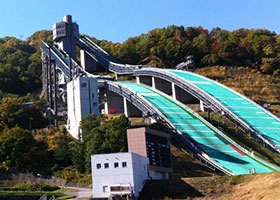
Completed in November 1992, this colossal structure capable of accommodating 45,000 spectators hosted the ski jumping events during the 1998 Nagano Winter Olympics. Athletes from all over the world competed on two differently sized ski jumping slopes--the Normal Hill (318 m) and the Large Hill (385 m)--resulting in two gold medals for the Japanese Olympic team.
Nowadays, the Hakuba Ski Jumping Stadium, which is located directly at the foot of Japan's Northern Alps, counts as one of Hakuba Happo-one's most popular sightseeing spots and is open year-round. Curious visitors can hop on the lift that runs between the two hills and get off at the tower, which provides access to the in-runs. While taking the elevator upwards, you may wonder why it's much taller than your average lift, but the additional space is necessary to accommodate long skis. From the observation deck you can enjoy marvelous views of the surrounding area, as well as imagining the thrilling anticipation of the athletes shortly before they jump off. The floors of the connecting passageways between tower and jumping hills were built with gratings, making it possible to admire the scenery below as well.
Occasionally the stadium is still used by ski jumping professionals for training purposes. Thanks to a slippery artificial surface, it is even possible to practice in the summer.
After exploring the ski jumping hills, venture out to the plateau on the opposite side and gaze at the Olympic cauldron. The Olympic fire was clearly visible from the top of the jumping hills to encourage the athletes.
The monument next to it was added after the 1998 Nagano Winter Olympics to celebrate and commemorate the 100th gold medal that was achieved by Japanese athletes at this competition.
-
Hosono Suwa Shrine
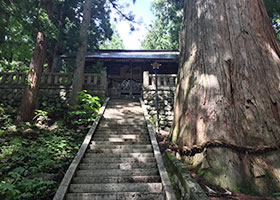
The first thing you notice while approaching this historic Shinto shrine nestled against a hillside is the giant sacred Japanese cedar at the bottom of the staircase. This ancient tree, which even survived a lightning stroke, is estimated to be at least 1,000 years old, and is over 40 meters tall and up to 10 meters in diameter. Surrounded by thirty massive conifers, this sacred tree has been designated a Natural Monument of Hakuba village.
The Hosono Suwa Shrine used to be the destination for villagers to pray for rain in the hope of a rich autumn harvest, but nowadays it's best-known as the site of the Reitaisai, Hakuba Happo-one's annual festival, and ninen-mairi, the shrine visit that marks the beginning of a new year.
The Reitaisai, usually in autumn, includes the Yukake Matsuri, a procession that features a portable shrine, which houses a 300 kg-heavy serpentinite rock, carried through the village. The shrine carriers are splashed with hot spring water from Hakuba Happo-one. The spectacle ends at Hosono Suwa Shrine, where everyone can feast on typical festival fare such as yakisoba (stir-fried noodles), butajiru (miso soup with pork and vegetables), and cotton candy-- and enjoy lively taiko drumming performances. During ninen-mairi, which takes place between the sun setting on the old year and rising on the new, the premises are beautifully illuminated and often covered by the sparkling white snow. This is the only night when you are able to purchase the coveted lucky charms of Hosono Suwa Shrine.
Since this sacred place is just a five-minute walk from the Adam gondola lift station, stop by at any time of year and take in the mystical atmosphere in this tranquil setting.
-
Hakuba Ohashi Bridge
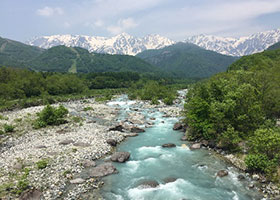
Selected as one of the 100 best roads and streets of Japan, the Hakuba Ohashi Bridge, completed in 1986, is the perfect vantage point from which to marvel at Mt. Shakushi, Mt. Yari, and Mt. Shirouma--three colossal mountains known collectively as Shirouma Sanzan.
Stretching over Matsu River, which flows with crystal-clear meltwater, the bridge has pedestrian walkways on both sides, from where visitors can take in the breathtaking views of this awe-inspiring stretch of Japan's Northern Alps. The bridge is dotted with informative signs that explain what to look for in the snow formations on top of each mountain throughout the year. For example, one vantage point lets you see the diamond-like shapes formed by falling snow, while another allows you to see the first Japanese character (八) of the area's name Happo-one etched in the ice.
Only a ten-minute walk from Happo-one's bus terminal and information center, Hakuba Ohashi Bridge is a detour well worth taking.
-
Oide Park
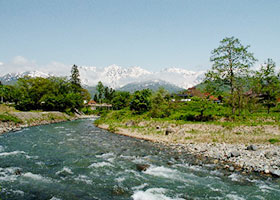
If you want to see how Japan's traditional rural landscape used to look, this little park offers a window to history. Encompassing an area of 5.9 hectares along both sides of the winding Himekawa River, the park was completed in 2006 and is dedicated to preserving Hakuba Happo-one's historical scenery.
You can enjoy the area's abundant nature, while getting to know the locals who inhabit the traditional buildings. The park's spectacular viewpoint is especially picturesque during cherry blossom season, but capable of taking your breath away at any time of year with its magnificent panorama of the Shirouma Sanzan mountain range of Japan's Northern Alps, the Himekawa River, the park's wooden suspension bridge and thatched houses. It is a popular spot for landscape painters, so with luck you can observe a masterpiece in the making.
Snacks and drinks are available at the Tsurihashi Teahouse, or the Kappa Tei Café, which occupies a one hundred-year-old structure with a small water wheel near its entrance. Here you can enjoy a range of dishes made from local produce, including pork from Hakuba and Shinshu salmon from Nagano Prefecture. (The Kappa Tei Café operates between May and October).
Museum
-
Hakuba Saegusa Art Museum
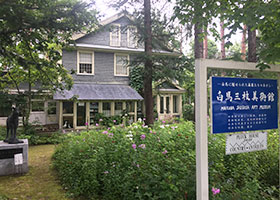
Set in a beautiful wooden structure resembling Western architectural designs of the early twentieth century, the Hakuba Saegusa Art Museum boasts around one hundred paintings by 80 of Japan's top artists, including Yayoi Kusama (1929- ), Ikeda Masuo (1934-1997) and Yamashita Kiyoshi (1922-1971). Most of the pieces are inspired by the beautiful scenery of Hakuba and Japan's Northern Alps throughout the seasons, channeling winter's crisp air off the snowy mountains or the fresh green grass and colorful flowers in the highlands during the spring.
The museum's adjoining sunroom provides its own beauty, allowing you to sip on a cup of tea while looking out onto the garden where hundreds of different flowers bloom between spring and autumn, while Japan's Northern Alps tower in the backdrop. (Note that the museum is open only between April and November).
-
Tetsuo Kikuchi Alpine Photograph Gallery
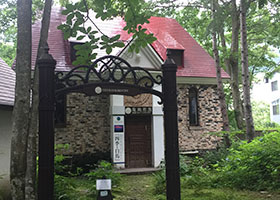
Throughout his career, Kikuchi Tetsuo, one of Japan's leading mountain photographers, captured the natural beauty of Hakuba's majestic Mt. Shirouma throughout a period of more than 30 years. Admire around 40 of his best works, selected by Kikuchi himself, at this two-story gallery. These large-scale photographs show the mountain during all four seasons--capturing the mountain's peak surrounded by an ocean of mystical-looking wintery clouds, scenery embraced by pink cherry blossoms during spring, and the autumn foliage reflecting in the mountain's large Happo Pond.
Kikuchi taught himself the art of photography at the young age of fourteen and devoted his talent to alpine photography six years later. He can look back at an incredible career that encompasses a host of solo exhibitions, as well as two teaching positions at the Nikon College and the Yamakei Culture Club. In 2007, the Tetsuo Kikuchi Alpine Photograph Gallery opened its doors in Hakuba Happo-one's Wadano no Mori area, in the premises of the Wadano no Mori Church. Before heading over to the gallery, a beautiful brick building with a red roof, purchase your ticket at the little hut located at the entrance to the premises, where you can also grab a coffee or tea.
Church
-
Wadano no Mori Church
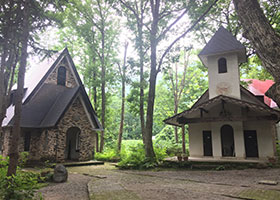
Nestled in the lush forest of Hakuba Happo-one's Wadano no Mori, this adorable brick structure with its peaked roof and detached bell tower was built more than 30 years ago. Walk down the little paved path and enjoy picturesque sceneries throughout the seasons, beautiful hydrangeas in the early summer, rustling colorful leaves during autumn, and a white lit-up landscape in the winter. Due to its fairytale setting, the Wadano no Mori Church is a popular wedding location among Japanese and international couples alike--and at certain days of the year, visitors can even enjoy classical concerts amidst this romantic and cozy atmosphere.
Directly next to the bell tower you can find the Tetsuo Kikuchi Alpine Photograph Gallery, which exhibits breathtaking large-scale images of Mt. Shirouma taken by famous mountain photographer Kikuchi Tetsuo. For those who want to stay a little bit longer in this tranquil ambience, sit down in front of the little hut next to the entrance and enjoy a cup of freshly brewed coffee or tea.
